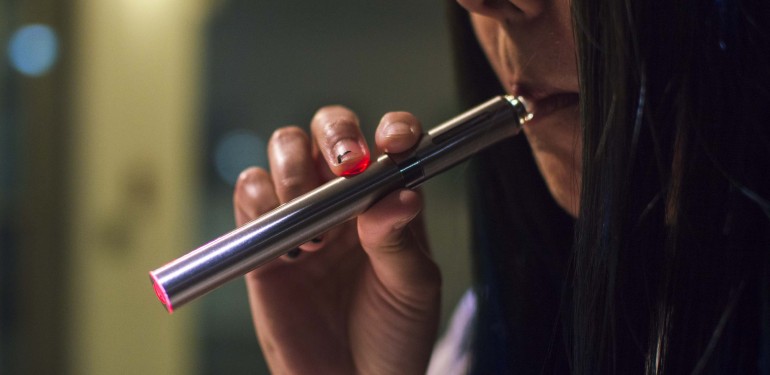(Photo credit: Alya Nowilaty/Fourth Estate)
This story was originally published in the Mar. 21 issue of Fourth Estate.
Last October, Mason updated its smoking policy to include vaping, which is no longer allowed within university buildings, after concerns from the community that secondhand vapor could cause health problems.
Janet Walker, the life/work connections manager for Mason’s Department of Human Resources and Payroll, said the new policy changes Mason’s former policy in two ways. First, it applies the same restrictions on vaping as it does on tobacco smoking, and second, Walker stressed that the language used in the policy changed from informing smokers and vapers where smoking was allowed, to telling them to keep specific areas smoke-free.
“The switch in focus from where smoking was permitted to where smoking/vaping was not permitted was designed to remind the community to keep the restricted areas free from secondhand smoke/vapor,” Walker said in an email.
In addition to no smoking or vaping in buildings, the new policy updates also specify that both smoking and vaping are not allowed within 25 feet of any window, building entrance or air intake.
The previous policy, which was titled “Smoke-Free Environment,” had been in effect since 2004.
“Smoking is permitted outdoors on university grounds, plazas, sidewalks, malls and similar open pedestrian ways, provided smokers are 25 feet or more in distance away from an entrance or exit of any facility, including parking garages,” read the old policy.
The new updates apply the same rules to vaping and e-cigarettes.
Senior communication major Frank Venzor said that he thinks the ban is a good thing. Venzor used to smoke traditional cigarettes, but tried e-cigarettes for a month.
“The idea was cool, but it is not as satisfying as an actual cigarette, so I started smoking them again,” Venzor said. “It [vaping] is also an unnecessary distraction in a learning environment.”
Senior Global Affairs major Margaret Hudnutt agrees with the policy change as well.
“I’m not certain what the science is behind vaping, but I do agree it should be kept away from enclosed spaces like buildings. Regardless of whether or not it’s harmful, it has a bizarre odor,” Hudnutt said.
Walker said that a working group was formed to “review and update” the university’s original policy, Smoke-free Environment. According to Walker, the group included representatives from Student Government; Staff Senate; Faculty Senate; University Life; Admissions; Human Resources & Payroll; Facilities; Risk Management; Student Centers; and Wellness, Alcohol and Violence Education and Services (WAVES).
A survey was conducted in the spring of 2015 that assessed what Walker referred to as “smoking policy and practice.” The survey’s results showed that 76 percent of participants believed that alternative smoking methods (such as vaping or hookah) could pose a risk to the user, while 78 percent believed that alternative smoking methods could pose a risk to bystanders.
“This [survey], combined with limited FDA regulation of e-cigarettes, the need for consistent university-wide policy on the subject and issues that were occurring on campus regarding vaping (e.g. an e-cigarette triggered a fire alarm), led the committee to move in the direction of restricting vaping in the same way as tobacco smoking,” Walker said.
While e-cigarettes and vaping are often used interchangeably, there are some slight differences between the two.
According to a USA Today article, “e-cigarettes are battery operated inhalers that consist of a rechargeable battery, a cartridge called a cartomizer and an LED that lights up at the end when you puff on the device,” and “vaping is defined as the act of inhaling water vapor through a personal vaporizer or electronic cigarette. When users draw on the device, the battery heats the liquid, which is then atomized into an inhalable vapor.”
Both e-cigarettes and vaping contain nicotine but not tobacco.
E-cigarettes and vaping are still fairly new in the United States, with sales only beginning in 2007, according to USA Today. Because of this, any potential long-term risks are not well known, but a study published in February of this year found that smoking and vaping result in diminished gene activity, decreased immune strength, and potential behavioral and reproductive problems for children of women who vape while pregnant. The study was performed by a group of toxicologists and was published in Science Magazine.
Hudnutt, a non-smoker, agrees with the study.
“I dislike the concept of polluting your lungs with toxins, and doing it in public areas in general. I think cigarettes are worse, but vaping hasn’t been around long enough for us to know the long term effects,” Hudnutt said.
Although enforcement of the new policy updates are still being discussed by the working group, Walker said that they hope the community will “exercise courtesy and kindness towards each other on this matter.”
In addition to the new policy updates, a “Courtesy Bridges the Difference” flyer is now added to the new faculty and staff hiring packets.
The flyer addressed both smokers/vapers and non-smokers/non-vapers and reminds non-smokers to remember that some smokers/vapers do not want to quit, that quitting can be difficult and that it is acceptable to politely ask smokers/vapers to move 25 feet from a building in accordance with university regulations.
The flyer asks smokers/vapers to adhere to university restrictions mentioned above; to dispose of waste in the proper receptacles; to be mindful of secondhand smoke; and to remember that while they may choose to smoke, others may not.
The flyer ends by urging both parties to “please be considerate.”




